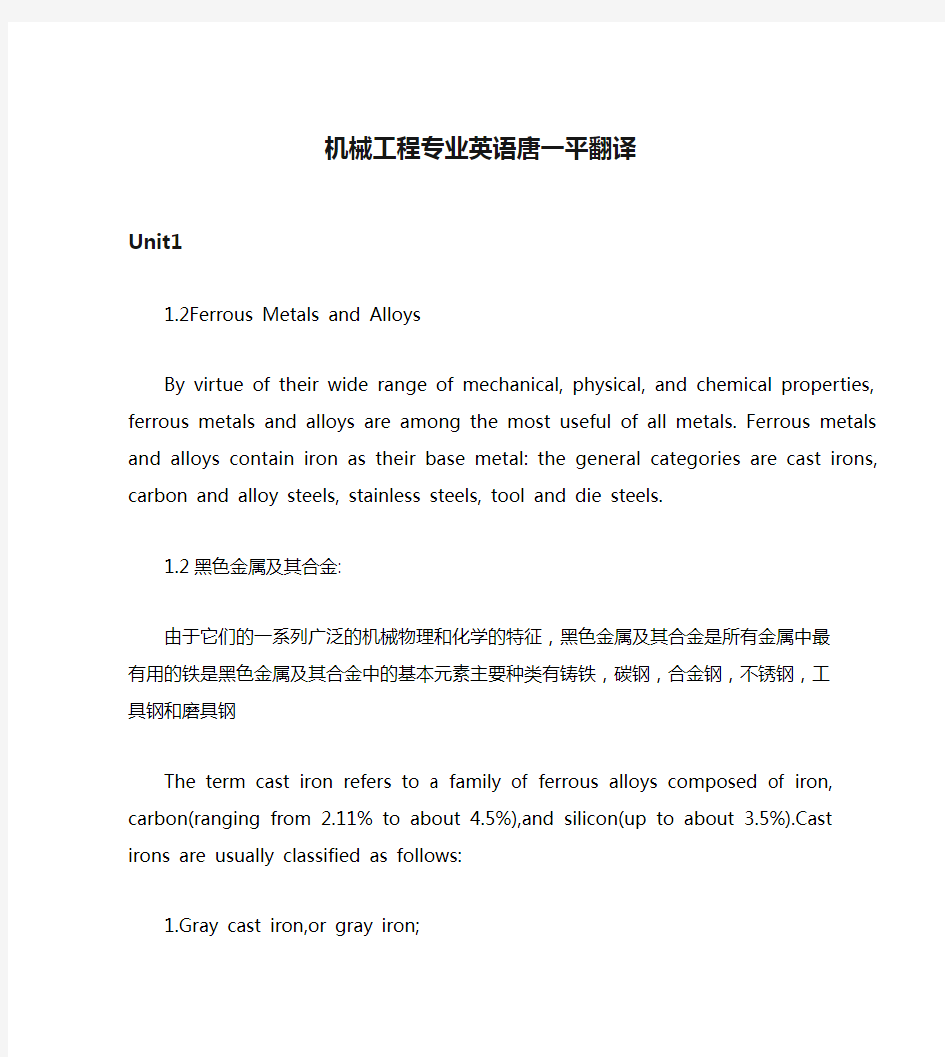

机械工程专业英语唐一平翻译
Unit1
1.2Ferrous Metals and Alloys
By virtue of their wide range of mechanical, physical, and chemical properties, ferrous metals and alloys are among the most useful of all metals. Ferrous metals and alloys contain iron as their base metal: the general categories are cast irons, carbon and alloy steels, stainless steels, tool and die steels.
1.2黑色金属及其合金:
由于它们的一系列广泛的机械物理和化学的特征,黑色金属及其合金是所有金属中最有用的铁是黑色金属及其合金中的基本元素主要种类有铸铁,碳钢,合金钢,不锈钢,工具钢和磨具钢
The term cast iron refers to a family of ferrous alloys composed of iron, carbon(ranging from 2.11% to about 4.5%),and silicon(up to about 3.5%).Cast irons are usually classified as follows:
1.Gray cast iron,or gray iron;
2.Ductile cast iron, nodular cast iron, or spherical graphite cast iron;
3.White cast iron;
4.Malleable iron;
https://www.doczj.com/doc/da2038914.html,pacted graphite iron。
( ),它包含铁碳(2.5%—4.5%)和硅( 3.5%)铸铁的分类如下1.灰铸铁2.球墨铸铁3.白口铸铁4.可锻铸铁5.如墨铸铁
The equilibrium phase diagram relevant to cast irons is shown in
Fig.1.1,in which the right boundary is 100% carbon,that is pure graphite.The eutectic temperature is 1154hC (2109hF), and so cast irons are completely liquid at temperatures lower than those required for
liquid steels. Consequently, iron with high carbon content can be cast
at lower temperatures than can steels. 有关铸铁的平衡相图如图1.1所示其右边界是100%的碳那是纯石墨,其共晶温度是1154?因此铸铁可以在比那些熔化
钢更低的温度下完全液化所以含碳量较高的铸铁的浇注温度比钢低。
Carbon steels are generally classified by their proportion(by weight) of carbon content.
1.Low-carbon steel, also called mild steel, has less than 1.30% carbon. It is generally used for common industrial products, such as bolts,nuts, sheet, plate, and tubes, and for machine components that do not require high strength.
3.碳钢:碳铜大体上是按碳含量的臂力来分类的
1)低碳钢又叫做软钢其碳含量小于0.30%它用于普遍的工业产品,例如螺栓,
螺母。钢板,港片钢管和那些强度要求不高的机器零件
Unit5
5.1 Introduction
Conventional machining is the group of machining operations that use single- or multi-point tools to remove material in the form of
chips.Metal cutting involves removing metal through machining operations.Machining traditionally takes place on lathes, drill presses,
and milling machines with the use of various cutting tools.Most machining has very low set-up cost
compared with forming, molding, and casting processes.However, machining is much more expensive for high volumes.Machining is necessary where tight tolerances on dimensions and finis
hes are required.
传统机加工是利用单刃或多刃刀具以切削形式去除材料的(一组)加工方法。金属切削就是利用机加工的方法去除材料,传统机加工都是利用不用的刀具在车床,钻床和铣床上进行的,与成型加工,模压制件和铸造工艺相比,机加工的准备成本还是比较低的。然而,如果是大批量生产,其成本要高得多,当对零件的光洁度和尺寸公差要求较高时,机加工是必须的。
5.2 Turning and Lathe
Turning is one of the most common of metal cutting operations. In turning, a workpiece is rotated about its axis as single-point cutting tools are fed into it, shearing away excess material and creating the desired cylindrical surface. Turning can occur on both external and internal surfaces to produce an axially-symmetrical contoured part.Parts ranging from pocket watch components to large diameter marine propeller shafts can be turned on a lathe. 5.1 车削与车床
车削是金属切削加工中最常用的方法之一。在车削过程中,一个工件绕其轴线回转,单刃车刀
沿工件进给,切掉多余的材料,最后形成要求的圆柱型表面,车削可以加工外表面以形成轴对称的
成型零件,从怀表的零件到大型螺旋角零件轴都可以在车床上加工。
Apart from turning, several other operations can also be performed
on a lathe.
除了车削,一些其它的操作也可以在车床上完成。
Boring and internal turning. Boring and internal turning are performed on the internal surfaces by a boring bar or suitable internal cutting tools. If the initial workpiece is solid, a drilling operation must be performed first. The drilling tool is held in the tailstock, and the latter is then fed against the workpiece. When boring is done in a lathe, the work usually is held in a chuck or on a face plate. Holes may be bored straight, tapered, or to irregular contours. Boring is essentially internal turning while feeding the tool parallel to the rotation axis of the workpiece. 镗削和车内圆:利用镗杆或合适的内圆车刀可以进行镗削和车内圆。工件毛坯如果是实心的,首先要钻孔,钻头安装在尾架上,后者向工件进给,如果在车床上进行镗削,工件一般安装在卡盘活花盘上。镗出的孔可以是盲孔、锥孔或者不规则的轮廓,当工具与回转轴平行进给时,镗削实际上是车削。
Unit7
Quality and accuracy are major considerations in making parts or structures. Interchangeable parts require a high degree of accuracy to fit together. With increasing accuracy or less variation in the dimension, the labor and machinery required to manufacture apart is more cost intensive. Any manufacturer should have a thorough knowledge of the tolerances to increase the quality and reliability of a manufactured part with the least expense.
在制造机器零件和结构的过程中,质量和精度是最重要的因素。互换性零件需
要有高精度以实现相互配合。随着精度的增加和尺寸变化的减小,制造零件所需的劳动力和机器更趋于成本密集型,制造商应该对公差有全面的了解,并以最小的成本提高加工零件的质量和可靠性。
An engineering drawing must be properly dimensioned in order to convey the de signer’s intent to the end user. Dimensions of parts given on blueprints and manufactured to those dimensions should be exactly
alike and fit properly. Unfortunately, it is impossible to make things
to an exact or dimension. Most dimensions have a varying degree of accuracy and a means od specifying acceptable limitations in dimensional variance so that a manufactured part will be accepted and still function. It is necessary that the dimensions, shapes and mutual position of surfaces of individual parts are kept within a certain accuracy to achieve their correct and reliable functioning. Routine processes do not allow maintenance(or measurement) of the given
geometrical properties with absolute accuracy. Actual surfaces of
the produced parts therefore differ from ideal surfaces prescribed in drawings. Deviations of actual surfaces are divided into four groups to enable assessment, prescription and checking of the permitted inaccuracy during production:
1:Dimensional deviations; 2:Shape deviations;
3:Position deviations; 4:Surface roughness deviations.
一张工程图应有恰当的尺寸标注,来把设计师的想法传递给用户,加工出的零
件尺寸应与图纸上所标注的零件尺寸完全一致并匹配,但是加工零件的尺寸不可能
是精确的尺寸,大多数的尺寸都有一个加工范围,这是可接受的规定尺寸变化极限的一种方法,以至于可以接受并使用这一加工零件,各个零件的尺寸精度,形状精度,互换位置精度必须保持在一个精度范围以内,以便正确可靠的实现他们的功能,常规的加工过程不允许对具有绝对精度的给点的几何特性进行维修和测量,因此实际零件加工表面不同于图纸中规定的理想零件表面,实际加工表面的偏差在进行评估说明和允许误差的检查过程中被分为四类:1.尺寸偏差,
2.形状偏差,
3.位置偏差,
4.表面粗糙度。